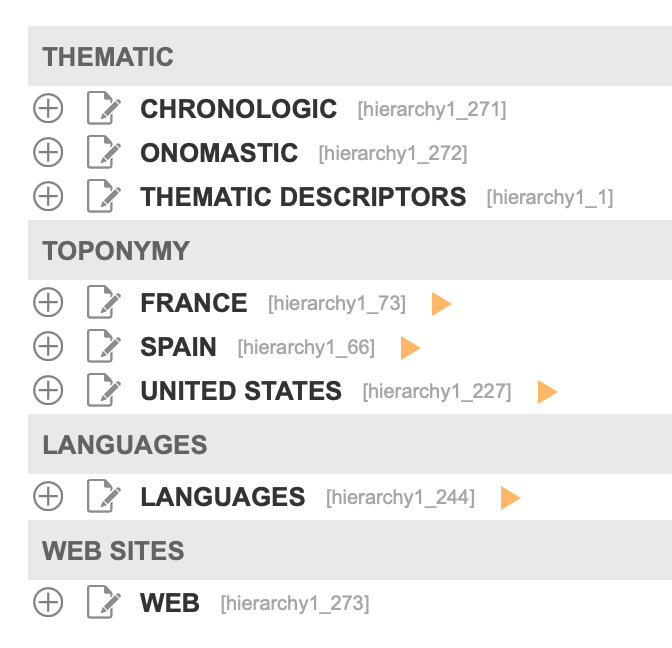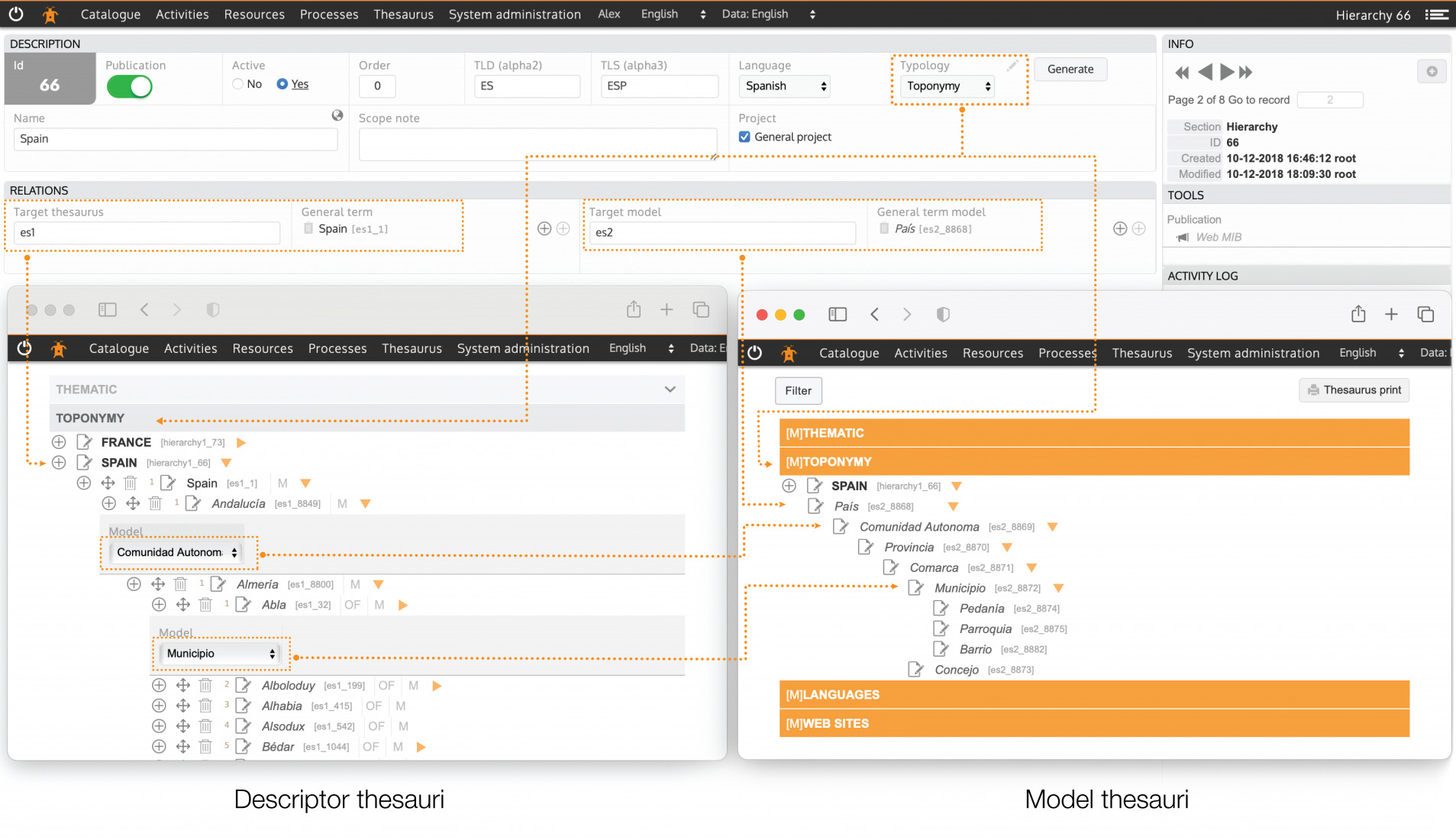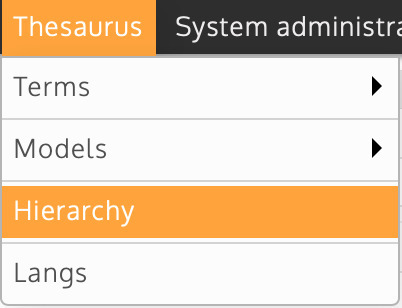Thesauri in Dédalo are hierarchically nested term structures related to each
other. Thesauri can define multiple scopes and uses.
The creation of a thesaurus is a complex process and involves the categorization of information following a "focus" of our project that we must define before starting. This approach to the thesaurus will be the look with which we will index the material and therefore will define how we understand, catalog and organize the contents of our project.
Dédalo is multi-thesaurus, that is, more than one hierarchical list can be created. This action can normally only be performed by administrator users from the "Hierarchies" section, therefore, if we need to create a new hierarchy, we must have administration privileges or contact the system administrator.
The creation of a thesaurus is a complex process and involves the categorization of information following a "focus" of our project that we must define before starting. This approach to the thesaurus will be the look with which we will index the material and therefore will define how we understand, catalog and organize the contents of our project.
Dédalo is multi-thesaurus, that is, more than one hierarchical list can be created. This action can normally only be performed by administrator users from the "Hierarchies" section, therefore, if we need to create a new hierarchy, we must have administration privileges or contact the system administrator.
Basic structure
By default in the basic installation of Dédalo, four types of thesauri are
created:
- The thesauri of toponyms of the countries that we have selected in the installation.
- The thesaurus of the languages of the world.
- Thematic thesauri with three approaches; thematic, chronological and onomastic.
- The publication thesaurus, which will be used to control the website of our project.
The first two thesauri have standardized descriptor terms and do not have to be modified, the last two do not have terms and are freely created. This basic structure can be expanded as needed through the hierarchies section that controls the amount of thesauri generated.

Hierarchies
Hierarchies are lists of descriptors or thesauri that contain the "terms"
used to describe or represent concepts, themes or contents ... of the topic to be dealt with by the
research study. These Hierarchies are created with the aim of carrying out a standardization of the
terminology to be used within the research study, which allows improving the recovery of the treated
material either by other researchers or by the public that accesses our collection.
Hierarchies consist of two structures:
The first and main one with the descriptor terms and the structure of different types of relationships that allow hierarchical information. Defining which term depends on another, hierarchical relation, or if it has an equivalence relation, synonymy, homonymy ... or semantic relation.
The second contains associated "models" with these hierarchies, these models contain meta-data of the descriptor terms of the main hierarchy. The terms of the models are not descriptors since they only contain information of the descriptor term to which it is associated. This is a parallel structure to the main structure that can be called to contextualize the descriptor term.
Hierarchies consist of two structures:
The first and main one with the descriptor terms and the structure of different types of relationships that allow hierarchical information. Defining which term depends on another, hierarchical relation, or if it has an equivalence relation, synonymy, homonymy ... or semantic relation.
The second contains associated "models" with these hierarchies, these models contain meta-data of the descriptor terms of the main hierarchy. The terms of the models are not descriptors since they only contain information of the descriptor term to which it is associated. This is a parallel structure to the main structure that can be called to contextualize the descriptor term.

In this section where we can create, modify or delete various
hierarchical lists.
Dédalo allows to generate different types of hierarchical lists to adjust to the focus of our work: Onomastics, Toponyms, Historical, Anthropological ...
Normally the hierarchies are created by the system administrator, but they can be edited, changed and completed by a user who has access privileges to the thesaurus.
Hierarchies created or activated from its "hierarchi" section of the thesaurus area, act and are displayed directly in the "thesaurus" section of the same module.
Dédalo allows to generate different types of hierarchical lists to adjust to the focus of our work: Onomastics, Toponyms, Historical, Anthropological ...
Normally the hierarchies are created by the system administrator, but they can be edited, changed and completed by a user who has access privileges to the thesaurus.
Hierarchies created or activated from its "hierarchi" section of the thesaurus area, act and are displayed directly in the "thesaurus" section of the same module.

Creating hierarchies 2
Dédalo allows free translation to any language, hierarchies have a
"default language" which is the language in which the new terms of the hierarchy are entered. These
main language will be use if the terms are not translated, the descriptor always need to have the
main language that will use as "fallback" when the other languages are not present. In addition to
the main language, Dédalo allows the translation of any term into any language regardless of the
languages used in other hierarchies and without limitation on the number of
translations.
By creating or modifying a hierarchy, you are declaring a new information organization and structuring model. Generating new Hierarchy you are modifying the Dédalo's Ontology. Think twice before activating or changing the structure of a hierarchies as it will affect various parts of the system. Some hierarchies are connected to specific fields and deactivation could generated an inconsistence data structuration.
Generally, when you install Dédalo, the most common hierarchies are created, but you are not limited in generating new hierarchies as needed.
By creating or modifying a hierarchy, you are declaring a new information organization and structuring model. Generating new Hierarchy you are modifying the Dédalo's Ontology. Think twice before activating or changing the structure of a hierarchies as it will affect various parts of the system. Some hierarchies are connected to specific fields and deactivation could generated an inconsistence data structuration.
Generally, when you install Dédalo, the most common hierarchies are created, but you are not limited in generating new hierarchies as needed.
Description and use of hierarchies
The hierarchies within Dédalo are identified with the international
standard ISO 3166-1. and they consist of 3 unique and univocal identifiers, the ID, the TLD
(alpha2), the TLD (apha3). These three data are required following the ISO standard.
By default, Dédalo includes the toponym hierarchies of all countries, standardized with their respective TLDs.
Before generate a new hierarchy, Dédalo will generated a unique id, and will be necessary enter the name of the hierarchy and a unique TLD (alpha2).
The main problem with TLD alpha2 is the limited combination of characters, it's useful for countries and toponymy, because this combination of 2 characters can reference the all world countries (around 280). But we need go outside this limitation for create new hierarchies.
The field TLD (alpha2) can only contain alphabetic characters (NOT numeric) but it can handle more than 2 characters. Don't use capitals, spaces, accents, dots, comas, especial characters or any other character than a-z characters. You can use any combination but only a-z characters.
The field TLD (alpha3) it's not use in custom hierarchies creation, you can specify it, but it will not use.
Defined the main language, it will use as default language term introduction. If you don't define it, Dédalo will use the default language installation, this can be confused.
You must also assign a "Type". The typologies are open to any nomenclature (Historical, Toponymy, Onomastic ...). You can use any definition of the hierarchy type. This field is used for grouping in the "thesaurus" section, so if we create a new type of hierarchy, it will appear as a section within that section (thesaurus).
If you have the field correctly you can press the "Generate" button. This action will create the hierarchy into the Dédalo's ontology and will be ready to use.
By default, Dédalo includes the toponym hierarchies of all countries, standardized with their respective TLDs.
Before generate a new hierarchy, Dédalo will generated a unique id, and will be necessary enter the name of the hierarchy and a unique TLD (alpha2).
The main problem with TLD alpha2 is the limited combination of characters, it's useful for countries and toponymy, because this combination of 2 characters can reference the all world countries (around 280). But we need go outside this limitation for create new hierarchies.
The field TLD (alpha2) can only contain alphabetic characters (NOT numeric) but it can handle more than 2 characters. Don't use capitals, spaces, accents, dots, comas, especial characters or any other character than a-z characters. You can use any combination but only a-z characters.
The field TLD (alpha3) it's not use in custom hierarchies creation, you can specify it, but it will not use.
Defined the main language, it will use as default language term introduction. If you don't define it, Dédalo will use the default language installation, this can be confused.
You must also assign a "Type". The typologies are open to any nomenclature (Historical, Toponymy, Onomastic ...). You can use any definition of the hierarchy type. This field is used for grouping in the "thesaurus" section, so if we create a new type of hierarchy, it will appear as a section within that section (thesaurus).
If you have the field correctly you can press the "Generate" button. This action will create the hierarchy into the Dédalo's ontology and will be ready to use.

The Hierarchy generated it's showed in the thesaurus area, as
"root" or "main" term of the tree, the hierarchy term it's NOT a descriptor and it's can't use
in the indexation process.
Some times you will need a descriptor term as root to use it at indexation process.
Some times you will need a descriptor term as root to use it at indexation process.

Toponymies
This type of hierarchies have the particularity of containing specific
geographic descriptors, this hierarchy fulfills two functions: the first is that its terms can be
used as descriptors in an indexing and the second is that its terms are used in captures, informants
... as identifiers geographical locations (place of birth, place of capture ...).
The toponym hierarchies must follow the Nomenclators of each country, although they can be expanded for locations that are not in these lists, for example villages, neighborhoods ...
The toponym hierarchies must follow the Nomenclators of each country, although they can be expanded for locations that are not in these lists, for example villages, neighborhoods ...
Languages
This hierarchy allows its terms to be used as descriptors in indexing
and also allows the identification of the languages of the projects, transcriptions or the
identification of the language of the hierarchies themselves. For example, a project that uses
Spanish as the main language plus two translations, French and Catalan, will use the Languages
hierarchy to link the project to these three languages.
All the terms of the hierarchies, projects, transcripts and any translatable element in Daedalus are associated with this hierarchy as an identifier of the language and its possible translations.
All the terms of the hierarchies, projects, transcripts and any translatable element in Daedalus are associated with this hierarchy as an identifier of the language and its possible translations.
Thesauri
The thesauri area has two different visualisations, flat, and tree. the
flat visualisation can be used as any other section of Dédalo, it has all terms in a list and it
possible edit in the same way that any other record of any other section (oral history, image, document,
etc.)
